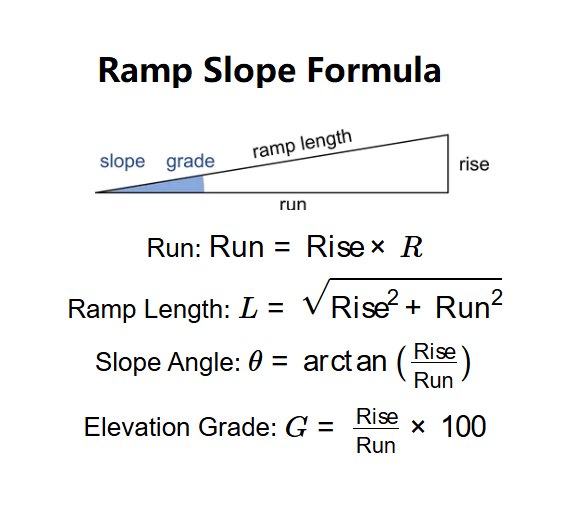1. What is the Ramp Slope Calculator?
Definition: This calculator determines the slope angle, elevation grade, run, and ramp length required for a ramp based on the vertical rise and a selected or custom rise-to-run ratio, suitable for various use cases like ADA-compliant ramps or residential applications.
Purpose: It helps architects, builders, and individuals design ramps for wheelchairs, strollers, or other mobility aids, ensuring safety and compliance with standards like the Americans with Disabilities Act (ADA) or residential needs.
2. How Does the Calculator Work?
The calculator uses the following equations, based on a rise-to-run ratio (e.g., 1:R):
- Run: \( \text{Run} = \text{Rise} \times R \)
- Ramp Length: \( L = \sqrt{\text{Rise}^2 + \text{Run}^2} \)
- Slope Angle: \( \theta = \arctan\left(\frac{\text{Rise}}{\text{Run}}\right) \)
- Elevation Grade: \( G = \frac{\text{Rise}}{\text{Run}} \times 100 \)
Where:
- \( \text{Rise} \): Vertical height to overcome (cm, m, in, ft, or yd);
- \( R \): Run multiplier from the selected ratio (e.g., 12 for 1:12);
- \( \text{Run} \): Horizontal length (m or ft);
- \( L \): Ramp length, the hypotenuse (m or ft);
- \( \theta \): Slope angle (degrees);
- \( G \): Elevation grade (percent).
Steps:
- Enter the rise and select its unit (cm, m, in, ft, or yd).
- Select a slope ratio (e.g., 1:12 for ADA max) or choose custom and enter a rise-to-run ratio (e.g., 1:10).
- Convert rise to meters for calculations.
- Calculate the run by multiplying rise by the run multiplier from the ratio.
- Calculate the ramp length using the Pythagorean theorem.
- Calculate the slope angle using arctangent.
- Calculate the elevation grade as a percentage.
- Convert run and ramp length to the selected output unit (m or ft).
- Display results, formatted in scientific notation if the absolute value is less than 0.001, otherwise with 4 decimal places.
3. Importance of Ramp Slope Calculation
Calculating the correct ramp slope and dimensions is crucial for:
- Accessibility: Ensures safe use for wheelchair users, per ADA standards (e.g., 1:12 to 1:20 for unassisted users).
- Safety: Prevents ramps from being too steep, reducing accident risks for assisted or unoccupied scenarios.
- Compliance: Meets building codes and accessibility regulations for public or residential ramps.
- Flexibility: Supports custom slopes for specific needs, like loading unoccupied chairs.
4. Using the Calculator
Example 1 (ADA Max Slope): Calculate the ramp parameters for an ADA max slope:
- Rise: \( 0.5 \, \text{m} \);
- Slope Ratio: 1:12 (Unassisted user, ADA max slope);
- Output Unit: Meters;
- Run: \( 0.5 \times 12 = 6 \, \text{m} \);
- Ramp Length: \( \sqrt{0.5^2 + 6^2} \approx 6.0208 \, \text{m} \);
- Slope Angle: \( \arctan\left(\frac{0.5}{6}\right) \approx 4.7636^\circ \);
- Elevation Grade: \( \frac{0.5}{6} \times 100 \approx 8.3333\% \);
- Result: \( \theta = 4.7636^\circ, G = 8.3333\%, \text{Run} = 6.0000 \, \text{m}, L = 6.0208 \, \text{m} \).
Example 2 (Custom Slope): Calculate the ramp parameters with a custom slope:
- Rise: \( 24 \, \text{in} \approx 0.6096 \, \text{m} \);
- Slope Ratio: Custom 1:10;
- Output Unit: Feet;
- Run: \( 0.6096 \times 10 \approx 6.096 \, \text{m} \approx 20 \, \text{ft} \);
- Ramp Length: \( \sqrt{0.6096^2 + 6.096^2} \approx 6.1266 \, \text{m} \approx 20.0984 \, \text{ft} \);
- Slope Angle: \( \arctan\left(\frac{0.6096}{6.096}\right) \approx 5.7106^\circ \);
- Elevation Grade: \( \frac{0.6096}{6.096} \times 100 = 10\% \);
- Result: \( \theta = 5.7106^\circ, G = 10.0000\%, \text{Run} = 20.0000 \, \text{ft}, L = 20.0984 \, \text{ft} \).
5. Frequently Asked Questions (FAQ)
Q: What do the slope ratios mean?
A: Ratios like 1:12 (ADA max) mean 1 unit of rise per 12 units of run (~4.8°, 8.33%). Lower ratios (e.g., 1:20) are gentler, while higher ones (e.g., 3:12) are steeper for specific uses like unoccupied chairs.
Q: Does the calculator account for ramp landings?
A: No, it calculates the straight ramp segment. For ramps longer than 30 feet (9.14 m) under ADA, landings (minimum 60 in or 1.525 m long) must be added separately.
Q: How do I enter a custom ratio?
A: Select "Enter a custom rise-to-run ratio" and input the ratio as "rise:run" (e.g., 1:10 for 1 unit rise per 10 units run). Ensure both parts are positive numbers.
 Home
Home
 Back
Back
